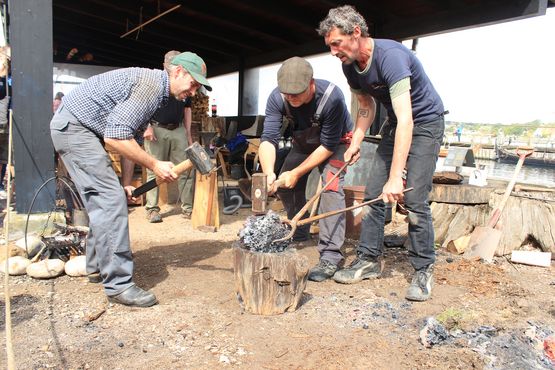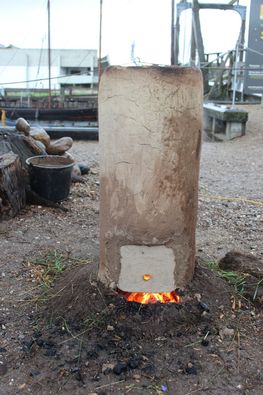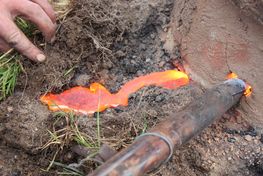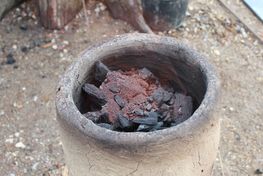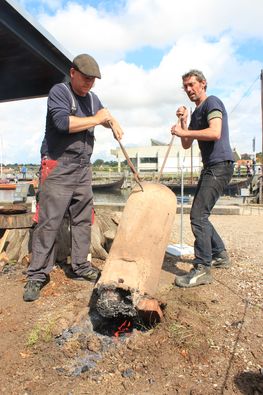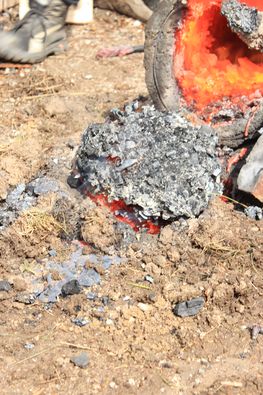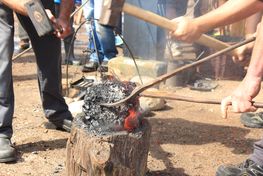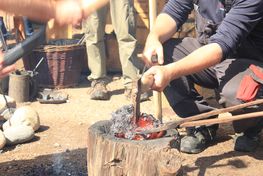It wasn’t the most auspicious of starts. Torrential rain and swirling wind tend not to be best friends with anything fire-related, but despite Mother Nature’s best efforts, the first day of smelting went off as planned.
The furnace was lit around 10am, to allow the worst of the rain to pass. It’s a very simple design – a cylinder of sand-grogged clay, 77cm high and with an internal diameter of 25cm. This is placed over a small hollow, 20cm deep. There’s a hole at the base of the furnace on one side, to allow a natural draught to fuel the initial fire, which warms up the furnace shaft. This is an important step in the process – if you were to start a full charcoal fire with air from the bellows without warming up the furnace first, the clay would get thermal shock and shatter.
After an hour, the furnace was warm enough to begin charging with charcoal. It was filled to the brim and the hole at the base of the furnace was sealed. Now the bellows were fuelling the fire and the temperature started to rise incredibly quickly. As the charcoal began to burn down, space appeared at the top of the shaft. This was then filled with charges of 1kg bog ore and 1kg charcoal, as and when the space became available.
By 1:30pm, the full charge of 23kg charcoal and 20kg bog ore had been filled, so now it was just a matter of letting the fire do its thing. As the ore is heated it separates into two different substances. Slag – a waste product composed of the impurities present in the ore and a proportion of iron – liquefies at a lower temperature than the iron itself. The slag trickles down to the bottom of the furnace where it gathers into a pool. Every so often, you have to tap the furnace at its base to allow the slag to empty. Mads managed to tap it once, the furnace took care of the remaining taps all by itself. Very obliging little furnace…
As the ore gradually breaks down, the iron begins to gather into a lump known as bloom. At around 4pm, after 5 hours of firing, the furnace was ready to be emptied. Mads plans to use to the same furnace for each of the five smelts this week, so it was a tense few minutes as he and Lars worked together to carefully lay the furnace on its side so the bloom could be removed. With an incredible heat radiating from the ca. 1400 degrees warm furnace, Mads used a long iron pole to push the bloom away from the base of the furnace.
The whole team was now on duty: Mads lifted the red-hot bloom with a long tongs and began instructing Lars and Jakob in how and when they should strike with the hammer to remove the slag and inclusions that were stuck to the bloom. Once the worst of the slag was removed, they used an axe to separate the bloom into two parts – this makes it easier to heat and hammer the bloom to remove the rest of the slag. After just a few minutes in Jonas’ forge, the bloom was back up to 500-600 degrees Celsius, and the work could continue. The first smelt produced 2.5kg iron and ca. 1kg of waste.
More on the production of the first rivets tomorrow…
